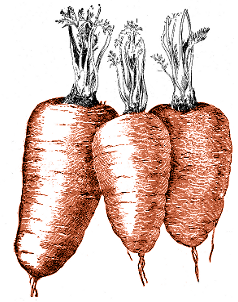Page 3 of 7
Posted in Garden Diary, The Old Garden In Bristol on Thursday, July 30th 2015 (9.04 PM).
The last time I posted here, it turns out, was over a year ago. I had plans. The garden might have been dormant and overgrown for a while, but I had definite plans. Now the children had reached the grand age of four months, I would have the time to get myself outside, finally finish off sorting out the back bed, plant things properly, spend time in the garden, spend time tending to and living in the garden.
Yes. So, of course, that didn’t happen. And the bramble bush that had rooted itself in one corner of the back bed grew, grew and grew, trying to colonise the sunny side of our tiny plot.
My parents last moved house when I was four years old. In the two or three months between my parents moving house, and my grandfather dying suddenly, I remember him giving my parents a bramble bush – or rather, a bramble cutting, rooted in a blue plastic bucket he had clearly cadged from the builders’ yard round the corner from his house: it was the sort of thin plastic bucket you get ready-mixed plaster and suchlike in. I don’t remember his exact words, but I remember the sentiment. Keep it in the bucket, he said. Plant the bucket, make sure it stays in the bucket, and you’ll be fine.
It did not, of course, stay in the bucket; my parents evidently were not watchful enough to look out for runners coming sideways over its flimsy plastic edge. By the time I was ready to leave primary school, most of the garden – a quite large garden, I should add, much larger than ours now – was taken over by one large bramble bush, taller than me, taller than my parents, tough, thorny, and impenetrable. Every summer my mother would pick the brambles from it, and make jam. I have a very clear memory of the last summer this happened – at a rough guess, I would have been about 12 or so. We spent a long, hot afternoon picking every ripe bramble we could reach, eating the odd one or two, before dumping the whole lot in the kitchen sink to be washed. My mother filled the bowl full of brambles with water to soak them, and three or four tiny maggoty wormy things crawled out of the centre of each fruit.
Having spent a few hours eating what turned out to be maggot-infested brambles, my mother decided at that point that the bramble bush had had its day lording it over the otherwise barren wasteland that was their back garden. Somehow she persuaded me that I ought to chop the thing down, so I spent a couple of days of my summer holiday gnawing away at it with secateurs and, for the thicker stems, a junior hacksaw. After more stuck thorns than I could count – we didn’t have anything resembling gardening gloves in the house – the enormous bush, taller than any of us, had been replaced by a slightly more compact pile of canes and stems and branches, still taller than any of us. My dad hired in a wood-chipper, and we spent a fun evening feeding the remains of the bramble bush into it, until nothing likely to root itself was left. The roots were left in the ground (I had sawn all the stems off just above ground level, and my dad certainly wasn’t going to go out there and dig them up), and after a few years’ recuperation they did find the energy to send up the odd stem here and there once more again, but the bramble bush’s days of dominating the garden were over and gone.
So, when I realised our garden was becoming at risk of being overrun, I was in two minds. On the one hand: happy memories of picking and eating them. On the other, I was always aware in the back of my mind that there’s a very real risk here. If I don’t do anything about it, in a year or two, we will barely be able to leave the back door.
We don’t really want that to happen: for one thing, we want the children to be able to run around in the garden and use some energy up. So, after the fruits have been gathered in, it is going to get the chop, although I’m not going to go to the extreme of hiring a wood-chipper to give it the final coup de grace. And tonight we collected our first bowlful.
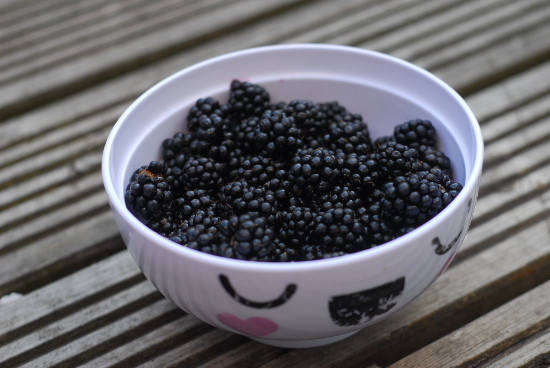
Do they count as foraged if they’re wild things in your own garden? The last time I ate foraged brambles, they were from a wet and misty island in the Bristol Channel, and they tasted of almost entirely nothing at all, soggy cotton wool with a vague hint of fruit to them. These, on the other hand, are the exact opposite, little balls of dense, concentrated tartness, nothing at all like a bramble from the shops. Far too tart to give to the children raw, despite how much they love the shop-bought ones. Hopefully we’ll be able to turn them into a compote of some kind. Hopefully, too, there aren’t many maggots inside.
blackberry, bramble, foraging, Rubus fruitcosus
Posted in Garden Diary, The Old Garden In Bristol on Sunday, March 23rd 2014 (9.16 PM).
It hasn’t been a cold winter, but it feels like it’s been a long, wet winter, a winter for slugs and snails. Moreover, the last time I wrote something on this blog, we had zero children in the family. Today, we have two children in the family; things have been a little busy in the past few months.
Spring has sprung, though, and the summer flowers I mentioned previously are starting to bloom. The borage plants have sprung up thick, hairy stems, looking ridiculously large in the box they are growing out of, hanging clusters of buds starting to open. Here’s a picture from a couple of weeks ago, just before they did:
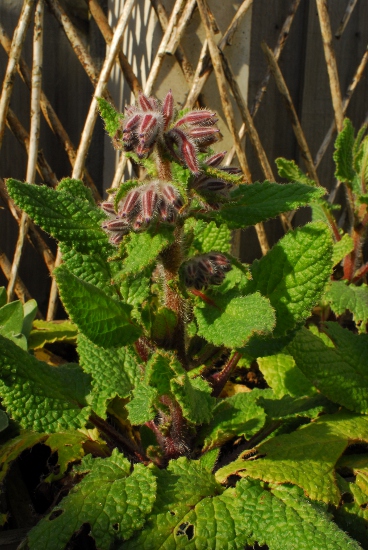
One calendula plant has blossomed; the rest have fat buds nestling in their hearts. One box of the forget-me-nots is a green carpet with one or two small, gemlike lilac flowers starting to appear.
Strangely, though, not all of the flowers are doing as well as the others. We planted five boxes, in a line on top of the garden wall, borage in the middle, calendula either side, forget-me-nots at either end. The two boxes on the shadier side of the borage are doing very well; on the other side, the calendula has a couple of slightly sick-looking plants in it, and the forget-me-not box has a couple of small seedlings, hardly anything compared to the thick growth at the other end of the wall. If anything, I would have thought things would have gone the opposite way around, and the sunnier boxes would be those doing best.
The white clover we planted as a green manure had also flowered, beautiful tiny white flowers. It was probably supposed to be dug in before that happened; never mind. Today, I turned it all over, and also tried to get up the taproots of a couple of dandelions that had settled in there over the winter. No doubt I didn’t quite manage to dig all over the clover up; I’m not really bothered if I didn’t. If we ever have a garden large enough for a lawn, I’d much rather fill the space with camomile, clover, and other similar low-growing plants. Next week, after the clover has started to rot down, I will try to make sure I sow something else.
borage, calendula, clover, forget-me-not, white clover
Posted in Environmentalism, Garden Diary, The Old Garden In Bristol on Saturday, September 14th 2013 (10.32 PM).
There is one benefit, of course, to leaving the garden to go to seed for a year. It means that the wildlife can get along with things all on their own, without me coming along to pull up their homes and generally keep disturbing things. Whilst clearing the garden up in the past few weeks, we’ve seen lots of shieldbugs, crab spiders, caterpillars, various different insects and suchlike going about their own business and making the most of the place.
A couple of years ago, we bought a bee house, and nailed it up on the wall of the shed. It saw little use, to be honest, apart from by spiders and a couple of holes filled by a mason bee last year. This summer, though, leafcutter bees have found it, and made good use of it.
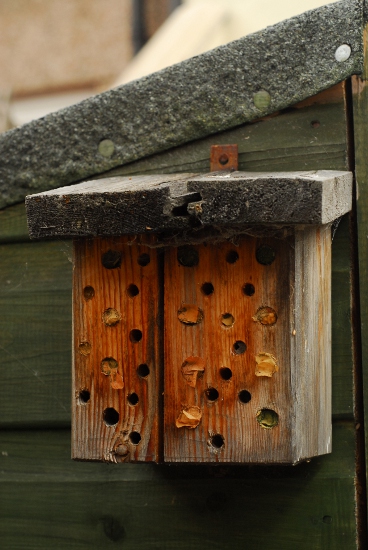
As you can see from the picture, leafcutter bees are quite picky about the sizes of the holes they will lay eggs in. You can also see one of the holes which a mason bee presumably crawled out of earlier in the year. Hopefully, at some point in the spring, a family of newly-mature leafcutter bees will emerge again.
In other news, we have sowed a few flowers ready for next summer: calendula, forget-me-not and borage. Slowly we’re drifting away from the original idea of making the garden as edible as we could, but that was never a strictly hard-and-fast rule to start with. They are, at least, all flowers which should please the leafcutters and bumblebees at various times next spring and summer. On the herb front, we’ve acquired a few stems of bay, and planted them in one of the wastebins used in previous seasons for growing potatoes. Growing potatoes is difficult to justify in a garden the size of ours; hopefully the bay will make a bush to last for a few years to come.
bay, bee, bee house, borage, calendula, forget-me-not, leafcutter
Posted in Garden Diary, Planning, Retrospective, The Old Garden In Bristol on Saturday, September 7th 2013 (10.29 PM).
Regular readers of this site – all one of you – might have noticed that things have been rather quiet for a while here. There is, of course, a good reason for that. The reason is: the state of the garden, in the second half of last year, was such a disaster that I really didn’t feel like writing about it. I really didn’t feel like going into the garden. And so, nothing was put away for the winter, everything was left to fend for itself. A surprising amount of plants survived the winter, but the ones that did were mostly killed off by the heat earlier this summer. So now, effectively, we are starting again. The only produce we’ve had from the garden in 2013 is a small bowl from an interloper, something very tasty that we didn’t really ask for.
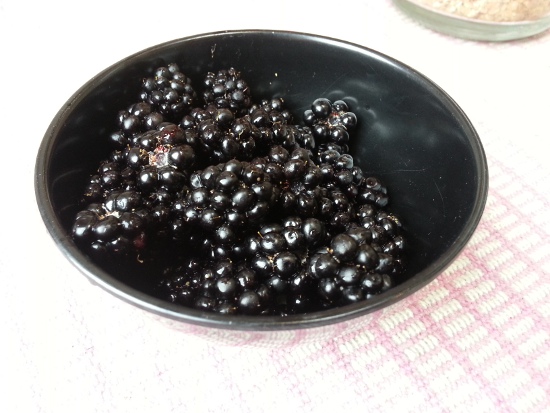
For some reason, gardening tasks always seem to end up involving brambles. I can dimly remember, aged about 5, my grandfather giving my parents a bramble shoot with the advice to keep it in a bucket lest it take over the whole garden. Naturally, by the time I had reached my teens, it had taken over, well, half the garden (the rest was lawn), and I spent what seems in memory to be most of a summer cutting it down, piece by piece, first with secateurs then with hacksaw, until my parents’ only option was to hire a wood chipper to deal with the pile of chunks. At the previous place we lived in Bristol, there was virtually no garden, and the only gardening task I ever did was regularly chop back a bramble which had managed to root itself under the decking. They really are amazing plants, in their ability to cover an area, take it over, turn everything underneath into a barren desert, and like bindweed they are endemic in this part of Bristol. So when I saw bramble runners sprouting forth over our back fence and dropping down seeking earth, I knew it had to go. After we’d eaten its fruit, of course.
The origin of the bramble is quickly explained, if we skip back to the garden plan posted a couple of years back:
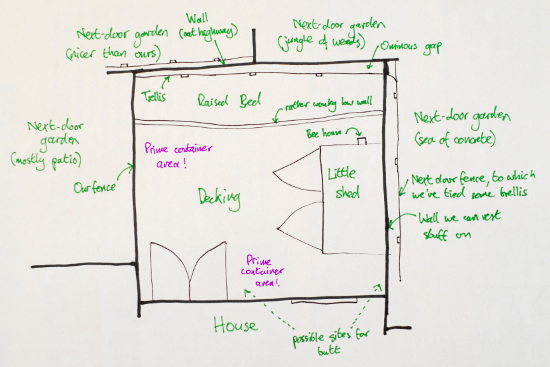
That area at top-right marked “Jungle of weeds” was all dug up about a year ago. They now have a shed, backing on to our boundary, and a high wooden fence extending off to the right. However, the cleared land on their side of said fence has been left to revert back to weediness. With their new fence, there is now double the Ominous Gap marked on the plan, and it’s this gap which has been colonised by bramble. I can reach down and chop off anything threatening to poke its way over into our space, but I have no hope at all of digging up the roots. In other words, my life is once again doomed to regularly cutting back brambles.
Apart from the bramble-hacking, what are we going to do now that we’ve admitted we’re going to restart from scratch? Try to plant things that don’t take as much nursing, for one thing, so that the garden will survive if we want a summer holiday; and things that don’t necessarily look appetising to every slug and snail in town. Lots of herbs, lots of insect-attracting flowers, and maybe the odd item of produce that we can’t easily buy here. For now, we’ve cut down the weeds that were colonising the back bed and sowed white clover for the winter, to refresh its nitrates and try to give the weeds no space to come back. Before the winter, we’ll start growing a bulb’s worth of garlic, and sow our spring flowers: of all last year’s produce, the garlic was the best harvest, and was barely touched by pests. Then, next year, hopefully things will be green again.
blackberry, bramble, clover, garlic, weeds, white clover
Posted in Garden Diary, Photobloggery, The Old Garden In Bristol on Saturday, December 1st 2012 (8.36 PM).
This week, it really feels as if the garden is properly getting itself going. More and more insects are out and about, and more things are starting to come alive. The lettuce and calendulas sown three weeks ago have just made their first appearance above ground, and the pea seedlings which have been growing on the kitchen windowsill are getting larger and larger, stretching their tendrils like the most grotesque of scarecrows. Today I started hardening them off ready for planting out; I probably should have done it earlier.
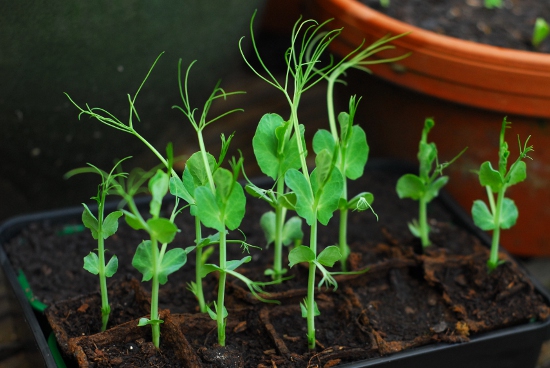
More peas will start germinating soon. The first batch of this year’s potato crop went into the ground today too – well, into their container. This year we picked Red Duke Of York, as something we are unlikely to see in the greengrocers, and I’ve tried to squeeze four tubers into the container rather than last year’s three. The second batch will be planted in about a month’s time.
To get the potatoes, we popped over to the Riverside in Southville. Naturally, we were rather tempted by their selection of herb plants. Possibly too tempted: intending go there purely to get potatoes, we also came home with a black peppermint, some sweet peas, and two fennel plants. The fennel is instead of the dill we grew last year; I will explain more about that later.
black peppermint, calendula, fennel, lettuce, marigold, mint, pea, peppermint, potato, spring, sweet pea
Posted in Garden Diary, Photobloggery, The Old Garden In Bristol on Sunday, July 22nd 2012 (7.20 PM).
The first batch of potatoes, Red Duke Of Yorks, is now up and out of the ground. By “ground” I mean “bin”, of course.
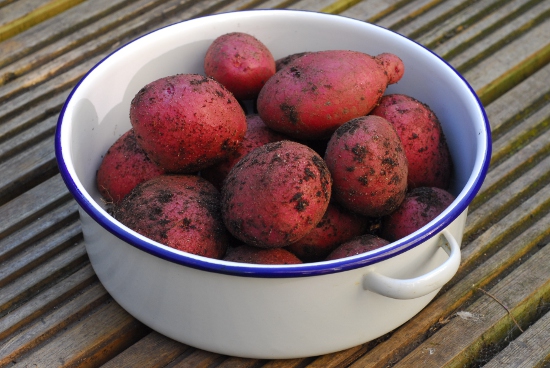
And when I say “first batch”, I mean “second batch”. The second batch of potatoes, the ones that were hugely leggy because their shoots were already six inches in length when I planted them, died off well before the plants from the first batch, one of which is still in full greenery. Presumably this is a result of the shoots being far too long; which, in turn, led to them having much more trouble with the bad weather.
harvest, potato
Posted in Garden Diary, Retrospective, The Old Garden In Bristol on Saturday, July 7th 2012 (2.50 PM).
A week ago, we passed the midpoint of the calendar year; a week or two before that, the midpoint of the solar year. A good place, I thought, to put together a little bit of a summary on how things are growing so far. With the weather, of course, it’s not going too well. There are bright spots, though. Here’s a summary, at least of the plants that are worth talking about.
- Potatoes: they’re not quite ready yet. Of the two batches of potatoes I planted, the first seem to be doing quite well. The second, though, are having problems. When I planted them, they were already far too leggy, and they stayed far too leggy as they grew. Because of that, they haven’t coped with the weather at all: they have flopped all over the place. For some reason, floppy potato plants are far more attractive to slugs and snails than tidy, well-behaved ones are.
- Green beans: the first batch were planted far too early, but happily sat in their pot for a month or two until the weather was warm enough. They’ve just reached the top of their poles, buds are starting to come, and the second batch I germinated are now ready to pot on.
- Runner beans: these went in a bit later than the green beans, and are already in full flower. They seem to be a little reluctant to set fruit, though; only one or two tiny embryo beans have been spotted so far. The standard advice for persuading beans to set seems to be “spray the flowers with water”, but given the weather I don’t really think that would help. Most of the salad leaves I planted around the base of the beans completely bolted before the weather turned wet, but some of the lettuce has been harvested and eaten.
- Garlic: also looking a bit windblown, and also not quite ready yet. They have, in the past couple of days, very quickly put forth a scape on each plant: the scapes are now safely in the fridge for eating.
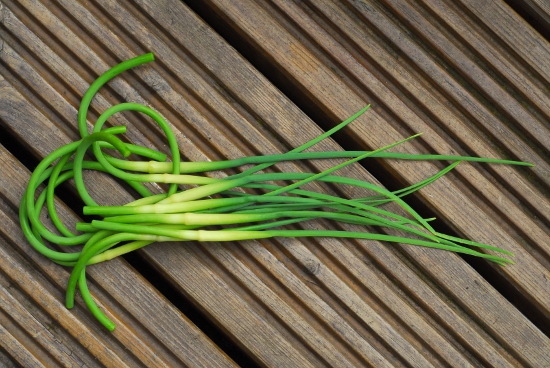
- Peas: if you ever hear anyone say to you “semi-leafless peas are self-supporting when sown in a block”, put your hands over your ears. And tape their mouth shut. And shoot them. This may be true in theory, but in reality I found that the growing peas could not cope at all with the weight of their pods. The first batch has already been harvested; and when I took them down, I could see just how twisted and serpentine the later batches have become. A final extra-big batch has been sown and planted on, spaced slightly further apart and with a lot more support provided by horizontal strings: I suspect the tight planting of the first couple of batches was the cause of the large number of pods with just two or three peas inside.
- Courgettes: the first of these were planted on about a month ago now, and seem to be doing fairly well. The first few flowers have bloomed: the problem is that with only a handful of plants, and the flowers only lasting a few days, it is difficult to get male and female flowers in bloom at the same time.
- Lemon balm: I picked these seeds up at the Bristol Seed Swap at the Cube Cinema back in February. Back in May, I put them in a pot, and waited for them to grow. Nothing happened, and I assumed something had gone wrong: all died, all rotted, all eaten by evil weevils. However, just this morning, I spotted one tiny seedling starting to emerge. Maybe it will turn out to be a lemon balm plant. So there’s a bright spot.
Writing out a list like this makes me aware of just how many different plants there are in the garden at the moment: I haven’t even had space to mention the mint; the basil mint; the peppermint; camomile; chervil; borage; French marigolds; English marigolds; cornflowers; thyme; lemon thyme; sage; rosemary; lavender; sweet peas; flat parsley; curly parsley; the fennel; or the chard. Probably best not to mention the chard at all, in fact, because I’m sure it’s a bad sign when your chard and your beans are the same height. Time to plant some more there, I think.
bean, chard, courgette, garlic, green bean, lemon balm, pea, potato, runner bean, summary, swiss chard
Posted in Garden Diary, The Old Garden In Bristol on Sunday, June 10th 2012 (10.52 PM).
We noticed last weekend that the first pods of peas looked ready for eating. You can’t make much of a meal from a couple of pods of peas, of course, so we ate the first one fresh off the plant, cracked open with my thumb and shared out in the garden.
The plants have all coped reasonably well with the past week’s bad weather. The potatoes, though, have been left rather rain-battered with a few stalks snapped off; and the garlic is looking a bit windblown. Hopefully none of this will affect what is under the ground.
garlic, pea, potato, weather
Posted in Garden Diary, Photobloggery, The Old Garden In Bristol on Thursday, May 31st 2012 (9.48 PM).
After 11 weeks, we have harvested the first crop of this year: “Ostergruß Rosa” radishes, planted back in March. I pointed out, last time I mentioned them, that we didn’t have much success with radishes last year. These, though, have been a lot more successful: a good clutch of long, fat roots.
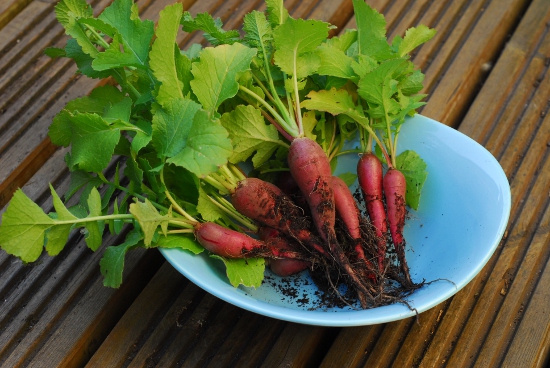
harvest, radish
Posted in Garden Diary, Photobloggery, The Old Garden In Bristol on Thursday, May 17th 2012 (9.47 PM).
The pea plants must be reading this blog. Three days ago, I said there was “no sign of any sort of flower yet” on them. And what do I see on each of the first batch of plants this morning?
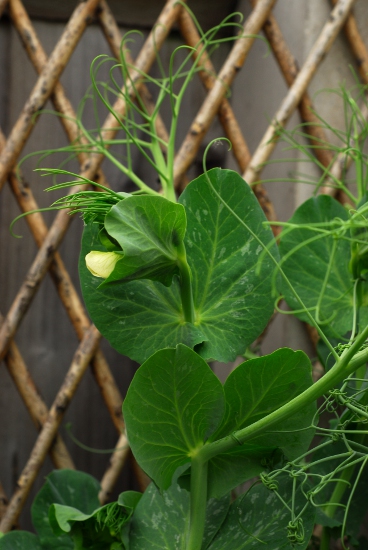
Fingers crossed they will all set fruit!
flowering, pea


